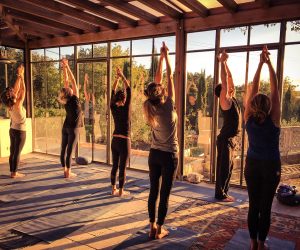
A sciatica stretching yoga has been a popular option for those suffering from sciatica. This exercise relaxes your piricus muscle. Lying on your stomach, pull your left knee toward you. You will then need to bring your left foot as close as possible to your navel. You can continue this stretch for five minutes until you feel no sciatic pain.
This pose will open up your hips. To do it, sit on the floor and bend your right knee. Your feet should be pointing towards your groin. Next, lower your head slowly. Hold this position for about a minute. Repeat the stretch on the left side. You can alternate legs for a few minutes. For greater effectiveness, try performing the poses on opposite sides. A massage may be a good addition to your yoga practice.

The sciatica stretch that is also great for the back is the child pose. Similar to the thigh standing, this pose can also be used. You'll fold your hands to your chest and bend your body. These differences are not significant, but they can be hugely beneficial for those suffering from sciatica. Begin by lying down on your stomach, your knees close to your feet and your big toes together. Once you are comfortable with the position, you can switch to another one and move up.
Before you practice yoga for sciatica you must first get clearance from your doctor. This will prevent you from developing further issues in your back. It is a good idea to consult your doctor before you start any new exercise program. Listen to your body and don't force yourself to do any activity that could cause sciatica pain. For instance, seated forward bends will strain the lower back. Instead, try supine-forward bends that support the hips.
Although some sciatica stretch yoga poses are challenging for people who have back pain, they can be very effective. There are many poses and positions that you can attempt. It is important to choose a class that meets your needs. The instructor will help you with the right yoga mat for your particular needs. Yoga for sciatica has many other benefits, but it is important to listen to your body. This can help to relieve sciatica and improve your quality-of-life.

Some exercises and poses can help prevent sciatica. The child's position, for example, can stretch your lower back and improve posture. It will also strengthen your piriformis. This will also reduce the pain in both your lower back, and your leg. It also improve your overall posture. It will also help you improve your sleep. But it's not just the pose that can help you with sciatica.
FAQ
What's a good workout routine for daily?
Regular exercise is key to staying healthy. It doesn't matter which type of fitness you choose, as long as it is done regularly. Consistency is the key. It is important to stay consistent in order to get results.
Begin by starting to do a little bit of physical activity each day (like walking). Start by walking for a few minutes every day. Gradually increase your time exercising to 30 minutes per week. You can do this running, swimming weight training, yoga or aerobics classes.
Try to get active every day. Don't skip any sessions unless you have a valid reason for not attending.
Make sure to wear appropriate clothing and footwear for outdoor exercise. Also, consider weather conditions and how they might affect your ability or safety while exercising.
When you exercise, make sure you are drinking plenty of water. Avoid alcohol consumption during this time as it can lead to dehydration. Avoid caffeinated drinks, such as coffee, tea and cola. They may give you energy, but they will also dehydrate you.
You might feel tired when you start to exercise for the first time. But if your workouts are continued, you will feel more energetic.
How many calories do I need to eat each day?
The exact amount varies depending on the person. The average is 2000 - 2500 calories per day. You need to determine how many calories you need based on age, gender, height, weight, activity level, and lifestyle.
How Metabolic Health is Key to Aging Well
People are living longer lives today than at any point in history. But as they do, they're also getting sicker. While medical science has made incredible advances, it's becoming increasingly obvious that the current approach is not working.
We have to change how we see health and aging. To achieve healthy aging, we must look at metabolic health as more than just weight loss. It is also important to consider overall wellness.
If you want to live a healthy, active lifestyle for the rest of your life, it is important to maintain a strong metabolism throughout your entire life.
The good news is that there are many ways to improve your metabolic health. One way is to include these 7 foods in your diet.
-
Blueberries contain resveratrol, which has been shown to help support cellular longevity. They also contain antioxidants and vitamins C & E.
-
Beans like lentils and pinto beans are excellent fiber and plant-based protein sources. These nutrients help to keep blood sugar levels constant so they don't spike and crash.
-
Broccoli is rich in sulforaphane. Studies have shown that it protects cells from DNA damage. It may even be able to slow down cancer progression.
-
Chia Seeds are high-in omega-3 fatty acids, fiber, and other nutrients. They're also loaded with antioxidants and protein. All of these nutrients are good for heart health, brain function, gut health, and overall health.
-
Green Tea has polyphenols called catechins. Green tea's catechins have been linked with reduced bone fractures as well as cardiovascular disease, cognitive decline, dementia, and increased diabetes risk.
-
Salmonis rich in vitamin D and low in saturatedfat, salmon is one of the best sources for lean protein.
-
Walnuts have omega-3s and antioxidants such as alphalipoic acid (ALA). ALA boosts energy production and reduces inflammation.
Statistics
- According to the American Academy of Dermatology (AAD), men over 50 are at a heightened risk of developing it. (healthline.com)
- An estimated calorie range for moderately active adult males falls between 2,200 to 2,800 calories per day, depending on age. (eatright.org)
- The PRS enabled risk stratification for overall prostate cancer and lethal disease with a four-fold difference between men in the highest and lowest quartiles (HR, 4.32; 95% confidence interval [CI], 3.16-5.89). (pubmed.ncbi.nlm.nih.gov)
- By John Thompson Take a whopping 38% off a set of PowerBlock Pros. (menshealth.com)
- Get free shipping and 25% off today. (healthline.com)
External Links
How To
How do I lose weight while working out?
Exercise can help you burn calories and increase your metabolism.
Moderate intensity exercise is a safe way to lose weight.
These are some tips to help you lose fat while working out:
-
Do cardio exercises such as walking, swimming, jogging, cycling, running, or elliptical training.
-
Exercise for 30 minutes three times per week.
-
Strength training is a great way to lose weight.
-
Avoid doing intense exercises. It's possible to build muscle, but not lose it.
-
Drink plenty of water during exercise. Water helps flush out toxins and keep your body properly hydrated.
-
Choose low-fat protein shakes after working out. Protein shakes are great for your muscles and energy.
-
Eat smaller meals throughout the day, so you don't feel hungry between meals.
-
Don't skip breakfast! Skipping breakfast can cause you to feel tired and sluggish.
-
Take care of your mental health. Stressful situations may slow down your metabolism.
-
Keep a positive attitude. Research shows that overweight people gain more weight if they believe they are overweight than those who believe they look good.
-
Sleep enough. Lack of sleep makes it harder to burn fat.
-
Keep active. Make sure you get up and move every hour.
-
Maintain a healthy diet. You will feel fuller longer if you eat right.
-
Relaxation is possible by finding ways to relax. A tense mind doesn't allow your body to release stress hormones that break down muscle tissue.
A balanced diet is one that includes all of the essential nutrients required for growth.
Instead of eating three large meals a day, eat six smaller meals every day. This allows your body to properly digest what you have eaten.
For strong bones to be maintained, you need approximately 500mg of calcium per day. Calcium can be found in dairy products such as yogurt, fortified soybean beverages, orange juice, cereals, bread, and cereals.
Calcium is found in leafy vegetables, beans and tofu, as well nuts, seeds and cheese.
Vitamin D is required for calcium absorption. Vitamin D is found in eggs yolk, fatty fish and fortified foods.
Vitamin E is crucial for skin health. It can be found as a vegetable oil, wheat germ, peanuts or almonds.
Your body needs zinc for normal immunity function and wound healing. Zinc can be found in seafood, legumes and meats.
Zinc deficiency can cause fatigue and loss of appetite. It can also lead to depression and impaired immunity.
Insulin resistance is caused by eating too much sugar, which can increase blood glucose levels. Insulin resistance leads directly to weight gain.
High levels of free radicals can lead to insulin resistance. Free radicals are molecules with unpaired electrons that damage cell membranes and other parts of the body.
The main sources of free radicals are food additives.
Free radical damage can lead cancer, heart disease or diabetes, arthritis, asthma, or other forms of aging.
To prevent free radical damage, eat a healthy diet rich in antioxidants. Antioxidants protect against oxidative damage.
Vitamin C, beta carotene (found within citrus fruits, carrots, sweet potatoes and spinach), Vitamin E (found inside nuts, olive oils, avocados and eggs), and Vitamin C (found among mangoes.
Selenium, copper and manganese are all antioxidant nutrients.
Selenium helps to protect cells against free radicals and oxidative stress. Selenium is also found in Brazil nuts.
Copper protects the eyes, brain, lungs, liver, and red blood cells. Copper is also found in poultry, meat, and organs.
Manganese is an essential component of bone structure. Manganese can also be found in oatmeal, brown rice, spinach and bananas.
Zinc is necessary for average growth, reproduction, and wound healing. Zn is found in lean meats, poultry, white fish and eggs.